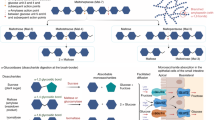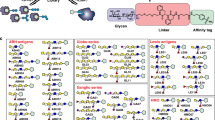Abstract
O-glycosylation is a post-translational protein modification that occurs in all eukaryotes. Yeasts have received increasing attention as a host for therapeutic protein production because of their ability to secrete high levels of recombinant protein. Because yeasts such as Pichia pastoris have been shown to O-glycosylate some proteins with varying effects on protein function, it is important to elucidate the nature of this modification. Methods that characterize O-glycosylation on a qualitative and quantitative basis are thus important when considering yeast as a host for therapeutic protein production. This protocol describes the release of O-glycans from a protein sample by β-elimination under alkaline conditions using sodium borohydride and sodium hydroxide. The released O-linked oligosaccharides are subsequently processed and then separated by high-performance anion exchange chromatography with pulsed amperometric detection (HPAEC-PAD). An estimation of O-glycan molar occupancy and average O-mannose chain length is ultimately derived. This protocol requires ∼3 d for completion. This method provides an assessment of O-glycosylation and allows one to correlate the effect of O-glycosylation on protein properties.
This is a preview of subscription content, access via your institution
Access options
Subscribe to this journal
Receive 12 print issues and online access
$259.00 per year
only $21.58 per issue
Buy this article
- Purchase on Springer Link
- Instant access to full article PDF
Prices may be subject to local taxes which are calculated during checkout



Similar content being viewed by others
References
Cregg, J.M., Cereghino, J.L., Shi, J. & Higgins, D.R. Recombinant protein expression in Pichia pastoris. Mol. Biotechnol. 16, 23–52 (2000).
Gerngross, T.U. Advances in the production of human therapeutic proteins in yeasts and filamentous fungi. Nat. Biotechnol. 22, 1409–1414 (2004).
Spiro, R.G. Protein glycosylation: nature, distribution, enzymatic formation, and disease implications of glycopeptide bonds. Glycobiology 12, 43R–56R (2002).
Choi, B.K. et al. Use of combinatorial genetic libraries to humanize N-linked glycosylation in the yeast Pichia pastoris. Proc. Natl. Acad. Sci. USA 100, 5022–5027 (2003).
Hamilton, S.R. et al. Production of complex human glycoproteins in yeast. Science 301, 1244–1246 (2003).
Hamilton, S.R. et al. Humanization of yeast to produce complex terminally sialylated glycoproteins. Science 313, 1441–1443 (2006).
Wildt, S. & Gerngross, T.U. The humanization of N-glycosylation pathways in yeast. Nat. Rev. Microbiol. 3, 119–128 (2005).
Willer, T., Valero, M.C., Tanner, W., Cruces, J. & Strahl, S. O-mannosyl glycans: from yeast to novel associations with human disease. Curr. Opin. Struct. Biol. 13, 621–630 (2003).
Trimble, R.B. et al. Characterization of N- and O-linked glycosylation of recombinant human bile salt-stimulated lipase secreted by Pichia pastoris. Glycobiology 14, 265–274 (2004).
Mochizuki, S. et al. Expression and characterization of recombinant human antithrombin III in Pichia pastoris. Protein Expr. Purif. 23, 55–65 (2001).
Ernst, J.F., Mermod, J.J. & Richman, L.H. Site-specific O-glycosylation of human granulocyte/macrophage colony-stimulating factor secreted by yeast and animal cells. Eur. J. Biochem. 203, 663–667 (1992).
Karlsson, N.G., Schulz, B.L. & Packer, N.H. Structural determination of neutral O-linked oligosaccharide alditols by negative ion LC-electrospray-MSn. J. Am. Soc. Mass Spectrom. 15, 659–672 (2004).
Huang, Y., Mechref, Y. & Novotny, M.V. Microscale nonreductive release of O-linked glycans for subsequent analysis through MALDI mass spectrometry and capillary electrophoresis. Anal. Chem. 73, 6063–6069 (2001).
Xia, B., Royall, J.A., Damera, G., Sachdev, G.P. & Cummings, R.D. Altered O-glycosylation and sulfation of airway mucins associated with cystic fibrosis. Glycobiology 15, 747–775 (2005).
Bigge, J.C. et al. Nonselective and efficient fluorescent labeling of glycans using 2-amino benzamide and anthranilic acid. Anal. Biochem. 230, 229–238 (1995).
Mattu, T.S. et al. The glycosylation and structure of human serum IgA1, Fab, and Fc regions and the role of N-glycosylation on Fc alpha receptor interactions. J. Biol. Chem. 273, 2260–2272 (1998).
Patel, T. et al. Use of hydrazine to release in intact and unreduced form both N- and O-linked oligosaccharides from glycoproteins. Biochemistry 32, 679–693 (1993).
Author information
Authors and Affiliations
Corresponding author
Rights and permissions
About this article
Cite this article
Stadheim, T., Li, H., Kett, W. et al. Use of high-performance anion exchange chromatography with pulsed amperometric detection for O-glycan determination in yeast. Nat Protoc 3, 1026–1031 (2008). https://doi.org/10.1038/nprot.2008.76
Published:
Issue Date:
DOI: https://doi.org/10.1038/nprot.2008.76
This article is cited by
-
Highly sensitive glycosylamine labelling of O-glycans using non-reductive β-elimination
Analytical and Bioanalytical Chemistry (2017)
-
A practical approach for O-linked mannose removal: the use of recombinant lysosomal mannosidase
Applied Microbiology and Biotechnology (2015)
-
In vitro enzymatic treatment to remove O-linked mannose from intact glycoproteins
Applied Microbiology and Biotechnology (2014)
-
The Impact of Glycosylation on the Pharmacokinetics of a TNFR2:Fc Fusion Protein Expressed in Glycoengineered Pichia Pastoris
Pharmaceutical Research (2013)
-
Hyphenated techniques for the analysis of heparin and heparan sulfate
Analytical and Bioanalytical Chemistry (2011)
Comments
By submitting a comment you agree to abide by our Terms and Community Guidelines. If you find something abusive or that does not comply with our terms or guidelines please flag it as inappropriate.



